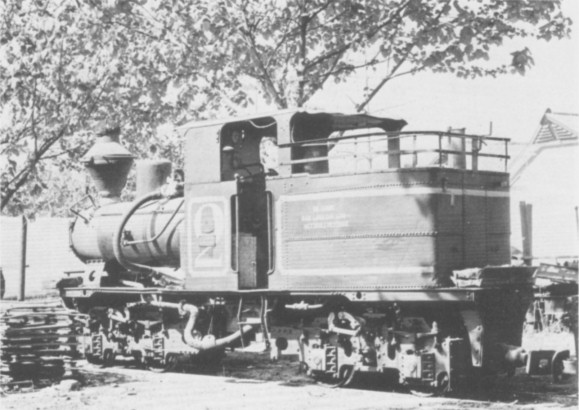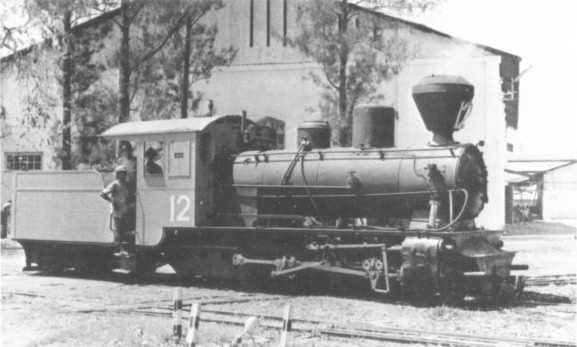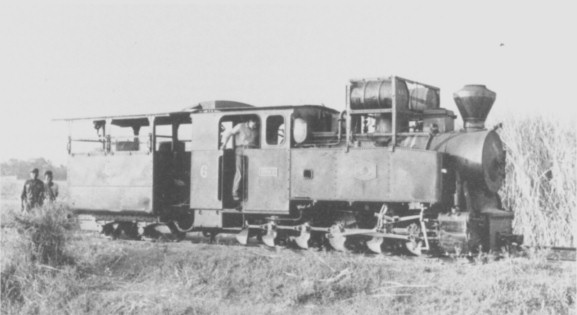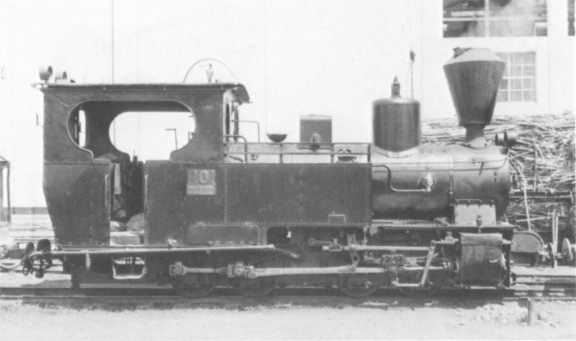
| THE INDUSTRIAL RAILWAY RECORD |
© NOVEMBER 1973 |
SOME FURTHER
INDONESIAN SUGAR MILL LOCOMOTIVES
FRANK JONES
Following the visit I made to Indonesia in 1971, a more ambitious trip, in the company of Frank Jux, was undertaken in 1972. Although more permits were available there was still much haggling as to where we could go: consequently much valuable time was lost.

Frank Jux's photograph of number 2, EPPO, a 70cm gauge Schwartzkopff (8782), brings to life the catalogue illustration on page 54 of RECORD 24. This locomotive was one of two of this type we located at Tjoekir Factory, the other (Schwartzkopff 8458) carrying running number 1. On these locomotives two inside cylinders (on the inner end of each power bogie) drive a central shaft on each bogie and these in turn are connected to each axle by chains. Both locomotives were cold but serviceable and after we had spent an unrushed half-hour inspecting them we were firmly led to the factory gate without seeing rivet or nut of anything else!

Orenstein & Koppel 10607, number 12 of Gempolkrep factory is a "Luttermöller" locomotive, having gear drive to the end axles. She was confined to yard shunting, being too heavy to go out into the fields. We also saw Pagottan 7 in August 1973 (see page 93 of RECORD 49) and it is quite definitely now running as a five axle "Luttermöller". Presumably when I previously saw it the gearing had been temporarily removed.

The third illustration shows number 6 at Sragi factory (Berliner 9317), working on a 60cm gauge system. The oil drums disfigure her appearance considerably. More to the point is that the loco has six cranks but only five axles! I understand from the late Herr Kemper that these 0-10-0 tanks had a form of articulation to the rear axle, and during our 1973 visit to Indonesia we were told that the sixth crank was for balancing. Is this in fact the case?

The preceding photographs show three different forms of articulation. We saw many examples of a fourth type (the Klein-Lindner) as applied to a rigid eight wheel drive. The outer axles are actually hollow, with the drive taken through to the wheels by a knuckle joint midway between the wheels on the end axles. On these axles the wheels themselves are guided by a type of pony truck. This form of articulation was very popular with Orenstein & Koppel and the final photograph shows number 10 of Kebonagung factory, a product of Orenstein & Koppel with "9356" on the motion. Borsig also used the Klein-Lindner axle, as did Du Croo & Brauns.
When the preceding types of articulated locomotives are compared with industrial locomotives built in Great Britain, we British must hang our heads in shame. Even today, on 60-75cm gauge systems, the number of Garratt locomotives operating is far outnumbered by Mallets.
'Messrs. Gray, Harrow, and Co, recently executed an order of five waggons to run on the Seaton Brick and Tile Co's light railway between the depot at the Bridge of Don and Strathbathie. These, it is stated, are the first light railway waggons built in the north of Scotland, the waggons previously running on the Seaton Brick and Tile Co's railway having been of English make. The waggons were built in a month's time, and are running on the railway and giving every satisfaction.' ("The Stone Trades Journal", December 1900. — SAL)
'ROBERT REGINALD BURNETT ... was one of the Assistant-Engineers on the Riga and Dünaberg Railway, under Sir J. Hawkshaw and Mr. T.C. Watson. Towards the end of 1877 he was offered and accepted the post of Engineer-in-Chief to the Chinese Engineering and Mining Company. During his stay of nearly six years in China he prospected, started and brought to a successful issue the coal-mines at Kaiping, near Tiensin; constructed a railway on the 4 feet 8½
inches gauge, about 7 miles in length, and a canal 22 miles long, both in connection with the above-named mines. This railway, which is still in operation, was the first line constructed in China, with authority, and on which locomotives have been permitted to run. The first of the three locomotives now in use was built at Kaiping, was named the "Rocket of China", and made its first trip on George Stephenson's centenary. Mr. Burnett ... unfortunately caught the typhoid fever, to which he succumbed at Shanghai on the 19th of August, 1883.' (Obituary Notice in Vol LXXV of 'Minutes of the Proceedings of the Institution of Civil Engineers,' 1883-84 Session. — RJB)